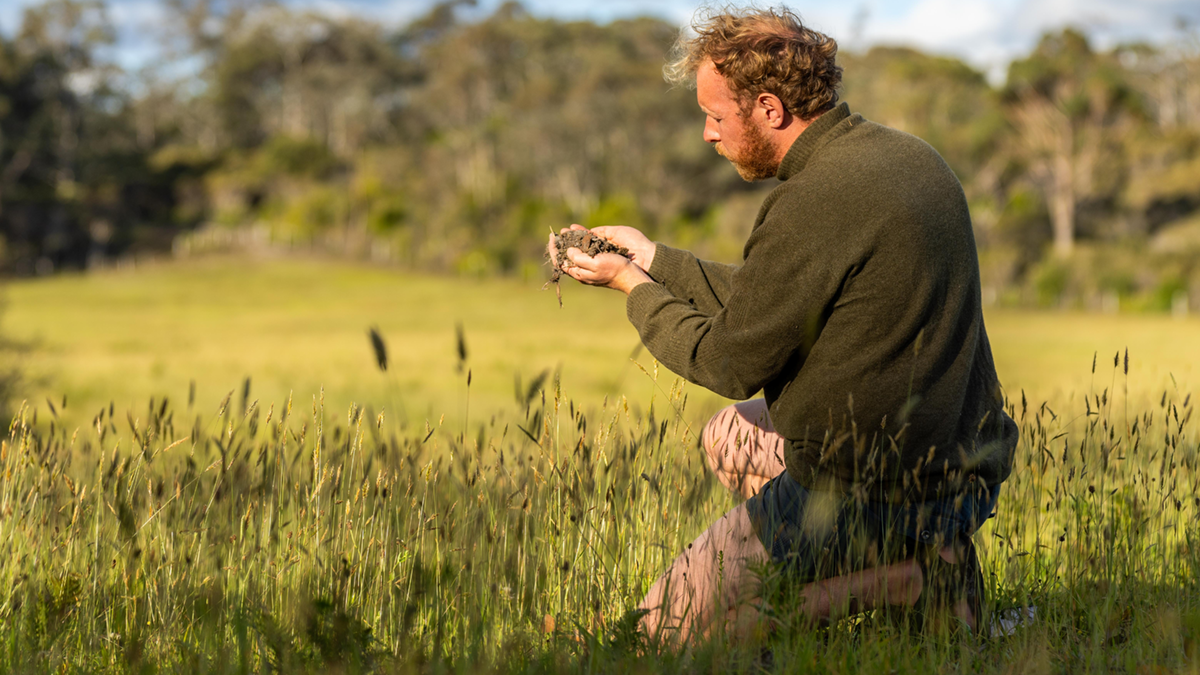Regenerative agriculture

David Burrows explores how the health of our soil impacts the quality of the food we produce
In September I spent two days in Amsterdam, at the second annual ‘Regenerative Agriculture and Food Systems Summit’. In the space of just a couple of years, this has become the topic that big food companies want to talk about. It offers huge potential in helping to fix what is clearly a broken food system. This is the chance, as one of the opening speakers put it, “to rewrite the narrative of agriculture”. But could it offer more than that?
At its heart, regenerative agriculture is about the soil and there are five underlying principles: don’t disturb the soil; keep the soils surface covered; keep living roots in the soil; grow a diverse range of crops; and bring grazing animals back to the land.
At its heart, regenerative agriculture is about the soil and there are five underlying principles: don’t disturb the soil; keep the soils surface covered; keep living roots in the soil; grow a diverse range of crops; and bring grazing animals back to the land. That might sound a little like ‘conservation agriculture’ or ‘biological farming’ systems but regenerative should go further and encompass farmer wellbeing and profitability too. As more than one speaker noted at the summit: “farmers can’t go green if they’re in the red”.
Whether food companies, governments or consumers are prepared to all help fix the system remains moot. ‘Who’ will pay for regenerative farming is one of many live debates which come under a broad theme of ‘what’ regenerative farming can deliver – environmentally, economically and socially. There are layers of questions beneath this, including: Can it achieve greenhouse gas reductions on the scale that some companies forecast? Will consumers pay more for regeneratively-farmed products – and should they even have to? Where do livestock, with their considerable environmental impact, fit into these systems? Can cows or chickens or pigs that are housed their entire lives be regenerative, for example? Can genetically modified or edited crops, or controversial chemicals like glyphosate be part of regenerative systems? However, one area that remains under the radar is health.
Everyone is talking about ‘healthy soil’ but as far as I can see there is little consideration of human health (at least in across ‘big food’). It was mentioned only briefly in two days, and more than a dozen panels and presentations in Amsterdam. “We haven’t talked about the food we are producing,” explains Geraldine Gilbert, food transition lead UK and Europe for Forum for the Future, an international sustainability non-profit organisation. Gilbert was one of the few to ask: where does diet fit into the current discourse? In one session she left Nestlé group head of sustainable agriculture thinking about this very question. It is about “people’s demands”, said Pascal Chapot. (Food companies always say they are there to grow and sell what people want to eat).
The response reminded me of an event I was involved in around this time last year. I was on a panel to discuss the media’s role in disseminating information around controversial climate topics like eating less meat. However, it was Professor Tim Benton, research director at the Chatham House thinktank, who stole the show (organised by Sustain, the alliance for better food and farming). Something he said stuck with me: “We don’t need to grow more food, we need to grow different food in different ways.”
Whether the marketing teams at major food companies ruin regenerative by greenwashing before it’s even germinated is certainly creating unease. It is a slightly woolly concept, and opinions are split on whether a stricter set of rules, or a certification, would actually make or break it.
Looking at the Amsterdam summit through this lens leads me to wonder, are we witnessing a full transition of the food system – one that is low impact and fair and leads to accessible, affordable and sustainable food. Or not? I am still chewing this over but there are a few things to consider. The first is this idea that regenerative farming is simply being woven into, or layered on top of, the current food system – what Adele Jones, executive director at the Sustainable Food Trust (SFT), refers to as “tweaks around the edges”. In a conversation we had as part of a new report for Footprint, a sustainability platform, she warned that the current dialogue, dominated of course by the major corporates, is leaning towards how to sell the concept. “People come at it the wrong way around: they think of a label and then work backwards,” Jones explains. Whether the marketing teams at major food companies ruin regenerative by greenwashing before it’s even germinated is certainly creating unease. It is a slightly woolly concept, and opinions are split on whether a stricter set of rules, or a certification, would actually make or break it.
Clear as mud
A label might provide an antidote to greenwashing but it’s not a sure bet (just ask anyone who has labelled goods with the now damaged concept of carbon neutrality). A more holistic ecolabel (which I discussed in a previous article for The Food Chain) could incorporate some of the benefits of regenerative approaches, like nature restoration, reduced use of chemical inputs, lower greenhouse gas emissions and higher animal welfare. “We need some clarity in this chaos,” says Maria Coronado Robles, global head of sustainability insights at Euromonitor.
Consensus on one label will be hard to find though. Much as it will for a regenerative agriculture one. The Regen10 group, an initiative involving major food companies and farming organisations globally, that was launched at the COP26 climate talks in Glasgow UK in 2021, is developing a framework for regenerative agriculture that it wants 500 million farmers to be involved with by 2030. For now, companies are by and large going their own way, which is risky. “Companies and consumers are both left wondering ‘what’s what?’” says Coronado Robles. Given its profile, there is relatively little research on how consumers feel about regenerative farming and food. Research published in September by McCain Foods and Demos, a think tank, did show that 70% of people are not yet familiar with the term ‘regenerative farming’ but there is significant support (around 70%) for the practice in principle.
What appears to be clearer, is that people want more (trustworthy) information so they can choose sustainable foods that align with their values. However, with myriad green claims thrown at them every time they shop or eat out, they are left baffled – and even by some of the simpler claims to verify.
Like carbon. Bord Bia’s Thinking House report, titled Consumer & Carbon Cutting through the Carbon Jargon, showed support for a global and European-recognised standard for carbon impacts was particularly high in Ireland. There is currently a lot of confusion about the claims and who to trust. It seems that companies may be ploughing a similar furrow with regenerative agriculture: there is already unease that, as with net-zero, there are currently more promises being made than progress. “Substance is key to build trust with both investors and consumers,” says Max Boucher, senior R&E manager (biodiversity and oceans) at Fairr, an investor consortium that represents over $70tn in combined assets. Boucher and his colleagues have just unpicked the commitments on regenerative agriculture that have been made by 79 of the world’s largest agri-food companies. Of the 50 that publicly refer to the potential of regenerative agriculture as a solution to the climate and biodiversity crises, 32 have yet to put in place any formal quantitative company-wide targets to achieve those ambitions.
Once again there is a lot of talk about soil health in the narratives but nothing about human health, nor the nutritional value of crops grown regeneratively. Should healthy soils not equal healthy crops and animals and in turn healthy people? I posed this question to one of the panelists in Amsterdam recently. He suggested that some early research is producing signs that healthy soil produces more nutrient dense food that enhances human health, but the challenge is “nailing concrete cause and effect in such a complex ‘system of systems’. It is certainly something people are looking at,” he added.
Two of those looking hardest are David Montgomery and Anne Biklé, authors of the book: What your food ate. “One of the big conclusions of the book is that what’s good for the land is good for us too,” explained Montgomery in a recent Investing in Regenerative Agriculture and Food podcast. They reviewed some 1,000 papers during their research and have also produced a peer-reviewed paper of their own, in the journal PeerJ. They studied paired vegetable, wheat and beef/ pork farms which followed either conventional or regenerative practices for five to ten years. Their paper notes that, despite the small sample sizes, “all three crop comparisons showed differences in micronutrient and phytochemical concentrations that suggest soil health is an under-appreciated influence on nutrient density, particularly for phytochemicals not conventionally considered nutrients but nonetheless relevant to chronic disease prevention. Likewise, regenerative grazing practices produced meat with a better fatty acid profile than conventional and regional health-promoting brands.”
“What we’re seeing initially in our data is that definitely, the ranchers that use these agroecological [or regenerative] practices, such as rotational grazing on biodiverse pastures, moving the animals around regularly, not overgrazing on the pasture, end up with the most favourable omega-6 to [omega]-3 ratios,”
Stephan van Vliet, a researcher at Duke University School of Medicine in the US, is another looking in detail at the way food is produced and its nutritional quality. “What we’re seeing initially in our data is that definitely, the ranchers that use these agroecological [or regenerative] practices, such as rotational grazing on biodiverse pastures, moving the animals around regularly, not overgrazing on the pasture, end up with the most favourable omega-6 to [omega]-3 ratios,” he said recently. There are also positive signs regarding saturated fats as well as phytonutrients – the compounds we get from eating plants but can also come in “meaningful amounts” from eating grass-fed animals, though we don’t yet know whether consuming these in meat has any human health effects, van Vliet explained.
Nutrients and nuance
Though our health isn’t front of mind when regenerative is discussed, start to dig and there is quite a bit going on. The Bionutrient Food Association (BFA) in the US has recently written about the assessments it has conducted on over 5,000 samples of almost 30 different crops across two continents. They showed that individual metrics like local vs. grocery store, organic vs. not organic, this variety vs. that variety, are not a good identifier of the overall nutrient levels of a crop. It is the overall system function of the soil, instead of claims like no-till or cover crop, which is “much more likely” to be the dominant causal factor in determining the quality of crops produced. So we can’t be tweaking around those edges. There is far more work to do of course (the BFA is doing human trials comparing grass-fed, grain-fed, and plant-based “meat” on a subset of the beef). But the potential of regenerative approaches to provide more nutritious food offers hope following plentiful research showing how our food may well look bigger and juicer than ever yet nutrient levels are falling.
It will certainly take time for us to learn about regenerative farming: what works, who benefits, and how it can scale. It will also take time to help consumers understand what it means for them, not to mention how they can identify it in stores (Waitrose and Marks-and-Spencer already have products available). Organic by contrast is simple, explains Gill Wilson, sustainability marketing professor at IE Business School in Madrid, Spain. Consumers see it as ‘no pesticides, better for my health’ and that’s all they need to know.
Crunch time
The debate over the nutritional qualities of organic food is more nuanced than that but it’s one that many consumers perceive to be true. They also see them as more environmentally friendly and natural, but again it’s not always clear cut. Whether regenerative will allow such perceptions to grow remains to be seen. Companies like PepsiCo have already begun planting the seed though. By focusing on regenerative practices, our farmers can grow nutritious quality potatoes, which we can all enjoy, says a spokesperson from Walkers. But can a packet of crisps really be part of a regenerative food system?



